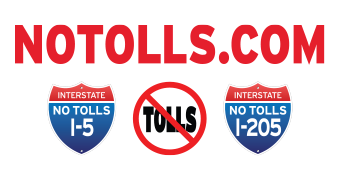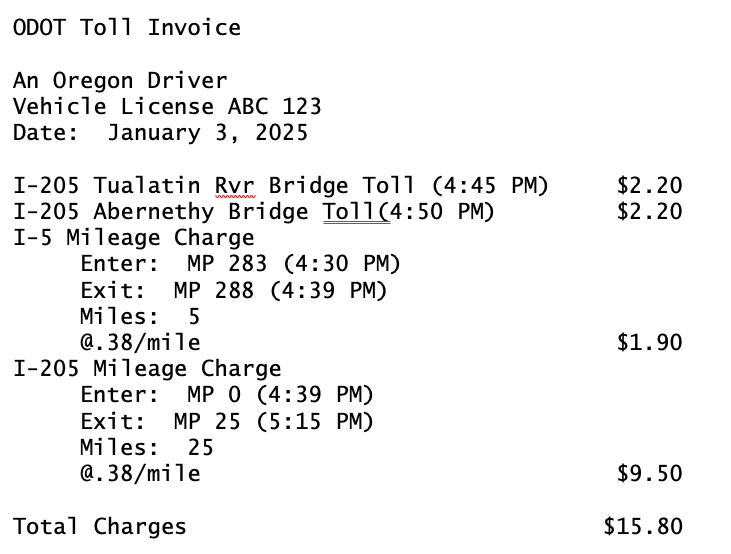$30 a day round trip between Vancouver and Wilsonville
By Joe Cortright — Feb 11, 2023 (City Observatory)
Under ODOT’s toll plans, A driving from Wilsonville to Vancouver will cost you as much as $15, each-way, at the peak hour.
Drive from Vancouver to a job in Wilsonville? Get ready to shell out as much as $30 per day.
Tolls don’t need to be nearly this high to better manage traffic flow and assure faster travel times. The higher tolls are necessitated by the need to finance ODOT’s multi-billion dollar highway spending spree.
ODOT is telling everyone to get ready for tolls, but they’re being close-mouthed about how much tolls will be. Here’s what they’re planning, according to documents obtained by City Observatory.
- Tolls on the I-205 Abernethy and Tualatin River Bridges will be $2.20 each at the peak hour. (Orange)
- Tolls on the I-5 Interstate Bridge will be up to $5.69 (Green)
- In addition to these tolls, drivers on I-5 and I-205 will pay tolls of 17 cents to 38 cents per mile during peak hours. Twenty miles of driving on I-5 or I-205 will cost you between $3.40 and $7.60. (Blue)
- People who don’t have transponders will also pay a $1.77 processing fee per transaction
ODOT’s planned tolls for Portland area bridges and highways
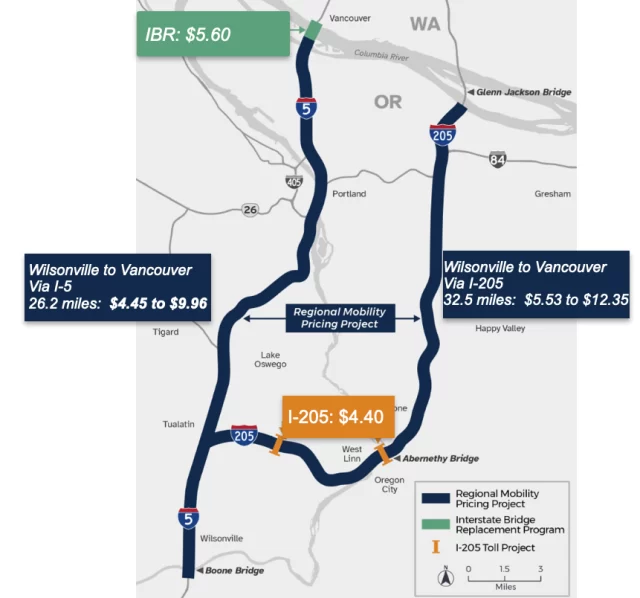
Here’s what your bill could look like for a trip from Wilsonville to Vancouver in just a few years.
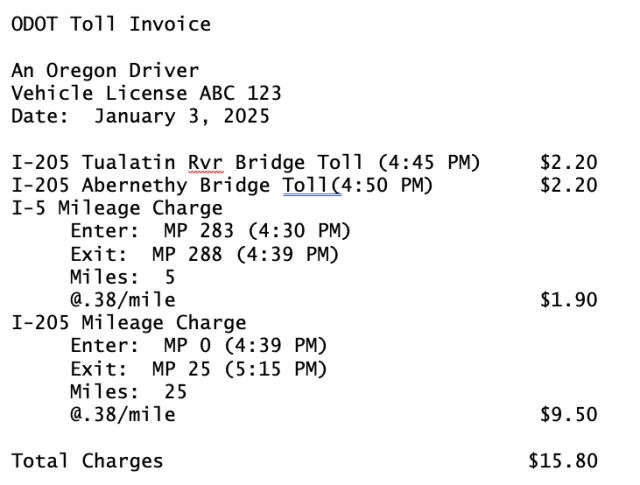
Of course, you have the option of taking I-5, rather than I-205, but if you do, your bill will be pretty similar:
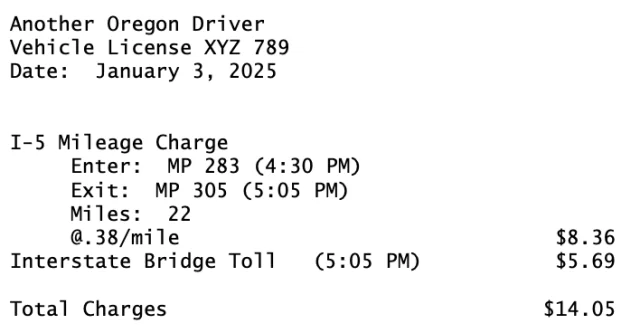
Why are the tolls so high? ODOT claims that the tolls are needed to manage congestion, but actually they’re planning on charging toll rates that are vastly higher, and that are poorly designed to actually manage traffic. The reason: ODOT is planning to go deeply in to debt to spend billions widening area freeways, and high tolls will be needed to pay back the bonds ODOT issues. ODOT has already decided to issue $600 million in short term debt (a kind of bureaucrat’s pay-day loan) to get the I-205 projects started. In the case of the IBR, ODOT and WSDOT will need a huge amount of toll revenue to pay for their super-sized $7.5 billion project.
If the tolls are set at levels that would just manage traffic they could be much lower at the peak hour, and could be zero in off-peak hours. The purpose of tolling should be to encourage people to travel at times when the highway system has adequate capacity. Most peak hour travelers don’t have alternatives, but a good proportion (20 to 30 percent, at least) do have the option of taking their trip at a different time, taking a different route, or using transit. Moving just a small portion of peak hour traffic off the freeway system means we’ll get much better service and travel times. But tolls could be much lower than those that would be required to pay off billions of dollars in bonds. There’s actually no reason to charge tolls overnight, and during most off-peak periods; freeways could still be “free” then, to encourage people to shift their trips to these less busy times, lowering peak hour congestion and avoiding the need for expensive road-widening projects.
Lower tolls would work better and be more equitable. Some people are concerned that tolling is inequitable to the poor. Research has shown that because higher income people drive more, drive farther, and are more likely to drive at the peak hour, that tolls fall more heavily on high income households. And even that low level of inequity can be lessened by setting toll levels at the lowest rates consistent with getting free traffic flow (and not high enough to fund super-sized highways). In addition, very low or zero off-peak tolls make the system more equitable because lower income people are much less likely that high income people to drive at peak hours. Finally, we ought to use toll revenues to fund a “transportation wallet” for low income households to offset their transportation costs however they choose to travel. Toll exemptions require you to buy a car to get any benefit, and do nothing to help those who don’t own cars or can’t drive.
I-205 Bridge Tolls: $2.20 each way on Abernethy & Tualatin Bridges
ODOT has been reticent to say what the tolls will be on I-205, but KGW-TV reporter Pat Dorris broadcast testimony at a recent Yamhill County Commission meeting in which ODOT staff revealed that tolls will be $2.20 on each of the two bridges on I-205.

According to the KGW story, ODOT will charge $2.20 peak hour tolls on the I-205 Abernethy Bridge between Oregon City and West Linn, and an additional $2.20 peak hour toll on the bridge over the Tualatin River between Stafford Road and West Linn. Those driving from Wilsonville to Oregon City would pay a $4.40 total toll at the peak hour. Look for ODOT to erect toll gantries over the I-205 roadway with license plate reading cameras and toll-taking transponders:
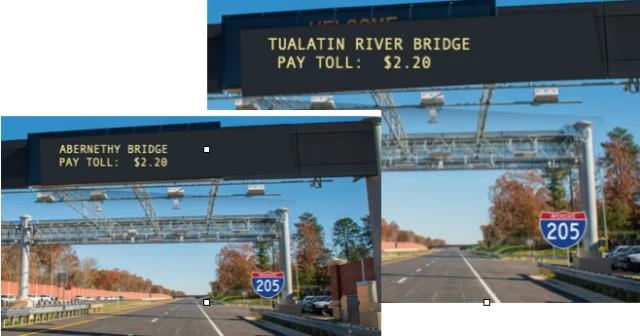
I-5 Interstate Bridge Replacement Tolls: $5.69 each way on the I-5 Bridge
Similarly, the Interstate Bridge Replacement project has not publicly said what toll levels it is looking at, saying opaquely that this will be decided later. But tolling is integral to the planning for the bridge: ODOT can’t estimate the volume of traffic likely to use the bridge without a good idea of what tolls it will charge (the higher the tolls it charges, the fewer vehicles will cross the bridge). City Observatory has obtained internal WSDOT and ODOT planning documents that show that the IBR project is looking at peak hour tolls of up to $5.69 each way at the peak hour for the new interstate bridge. Here is an April 4, 2022 email from Jennifer John (a transportation modeler for the IBR project) to Aaron Breakstone (a transportation modeler for Metro). It explains that they are studying tolls on way, peak hour tolls of $4.45 (in 2010$).
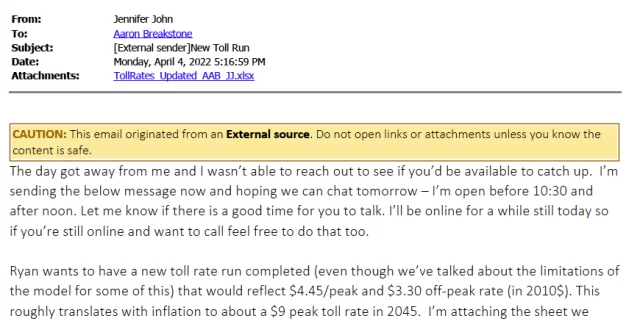
For analytical convenience, we’ve computed the current, inflation-adjusted value of a $4.45 toll in 2010 dollars–that is equal to $5.69 in today’s (2022 dollars) using the Bureau of Economic Analysis Implicit Price Deflator for Personal Consumption Expenditures (IPD/PCE)–the preferred method of making such comparisons.
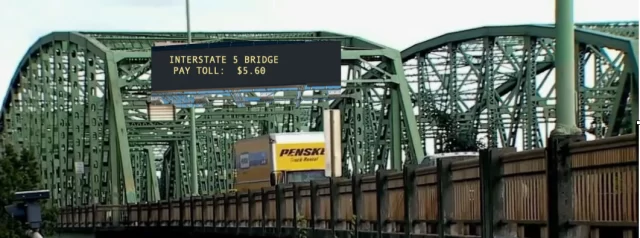
Congestion Pricing Charges: $10-12 from Wilsonville to Vancouver at Rush Hour
But bridge tolls aren’t the only road pricing that’s coming: Oregon DOT is also developing a “Regional Mobility Pricing Program (RMPP). ODOT’s plan is to institute per mile tolls on Interstate 5 and Interstate 205 between the Boone Bridge in Wilsonville and the Columbia River. The agency has kept the exact amount of tolls a closely guarded secret. Planning documents prepared in 2018 said that tolls of 17 cents per mile to 38 cents per mile would be needed to manage traffic under value pricing, the project now called the Regional Mobility Pricing Program.
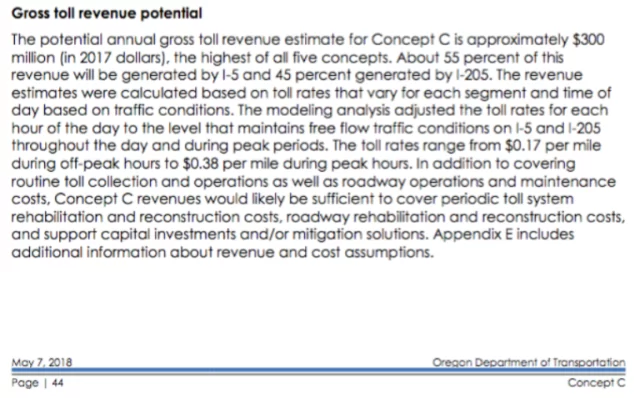
Shhh! Toll levels are a deep secret.
The typical ODOT line is something like the following: “Tolls will be set about six months before the project opens; tolls will be determined by the Oregon Transportation Commission, after public hearings.” Here’s the typical shine-on as reported by the Portland Tribune:
According to ODOT, the exact toll rate pricing will be based on congestion relief goals, revenue needs and public input. The exact pricing is expected to be announced about six months before tolls begin.
That non-answer begs the question about what toll levels will be. And for both financial and traffic forecasting reasons, ODOT has to know the approximately level of tolls well in advance. If it doesn’t know the toll level, it not only doesn’t know how much money tolling will provide toward the cost of the project, and critically, because tolls will depress traffic levels, it needs to know how high tolls will be to accurate forecast traffic (which determines the need for the project) as well as the amount of revenue. As a practical matter, ODOT staff and consultants have already developed working estimates of tolls, they’re just not making them public. (Notice the word “exact” appears twice, and that tolls will be “announced” six months in advance. Make no mistake: ODOT will decide the approximate level of tells well in advance; in reality, they likely already know).
City Observatory has obtained ODOT emails showing the agency is trying to keep the exact level of toll charges a secret–even from the Metro regional government and the City of Portland.
ODOT has resisted releasing any documents showing the exact level of tolls used in their traffic modeling. In October, 2022, City Observatory requested information on proposed toll levels and was told it would be charged over $2,000 to provide such information.
Regional Mobility Pricing Program Tolls
The regional mobility pricing program will charge drivers based on the distance they travel on I-5 and I-205, with rates varying by time of day. To illustrate the approximate range of expected tolls along I-5 and I-205, we’ve used Google Maps to compute the distance between the Boone Bridge in Wilsonville and the two freeway bridges across the Columbia River. The I-5 route between Wilsonville and the Interstate Bridge is 29.5 miles long. At 17 cents per mile, the toll would be $4.45; at 38 cents per mile the toll would be $9.96.
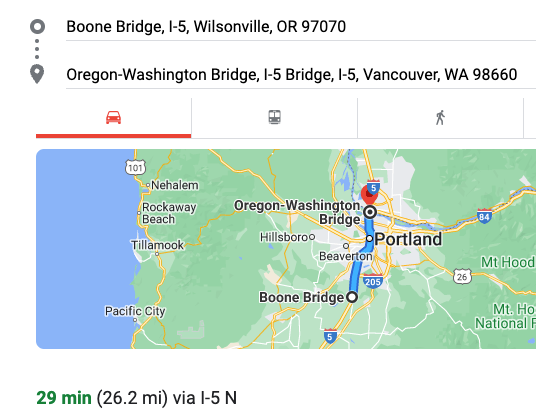
The I-205 route between Wilsonville and the Interstate Bridge is 32.5 miles long. At 17 cents per mile, the toll would be $5.53; at 38 cents per mile the toll would be $12.35.
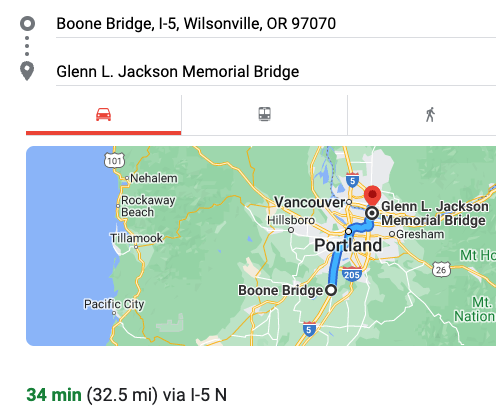
This calculation assumes that the Regional Mobility Pricing Program (RMPP) fees for the segment of I-205 between Stafford Road and Oregon City are in addition to the tolls charged at the Abernethy and Tualatin River I-205 bridges. ODOT has not revealed how RMPP tolls will interact with bridge tolls. If ODOT does not charge an RMPP toll on this segment of the freeway, the toll for a Wilsonville-Vancouver trip would be $1.19 to $2.26 less than these estimates.
Additional Fees for vehicles without transponders. $2 more each time if you don’t have a transponder.
For both bridge tolls, and for the congestion pricing system, OregonDOT is planning on barrier-free all-electronic tolling. Cars and trucks would pass under a toll-gantry, and antennae would communicate with in-vehicle transponders–small windshield stickers. Cars that didn’t have transponders would have their license plates photographed, and would be billed by mail.
Washington charges those without transponders an additional $2.00 when they travel through downtown Seattle’s tolled SR 99 tunnel:
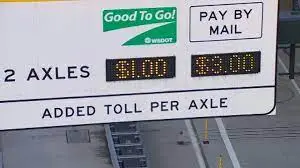
Those who are billed by mail would pay an additional surcharge to cover the costs of billing. Again, ODOT isn’t revealing how much that surcharge would be. Estimates prepared for the Columbia River Crossing said that the surcharge for “pay-by-mail” would be $1.77 per transaction. In addition, City Observatory has obtained more recent ODOT planning documents indicating that the surcharge would be $2.00 per transaction, just as in Washington.
Higher tolls for trucks: 3 to 5 times higher than for cars.
For I-205, ODOT told KGW that trucks would pay higher tolls—but declined to reveal how much higher. KGW’s Pat Dooris reports:
Currently, the planning model includes large trucks being charged higher toll rates than passenger vehicles.
A 2013 study paid for by ODOT for the Columbia River Crossing said that tolls for 18-wheelers would be four- or five-times higher than tolls charged to passenger cars. One-way peak hour tolls for 18-wheeler trucks would be $14.65. Trucks without transponders would pay another $2 for “pay by mail” processing.” We’ve obtained, via public records request, a 2022 ODOT study showing that trucks traveling on I-205 would pay four times the passenger car rate, or $17.60, one way, at peak hours—plus a $2.00 surcharge, if they didn’t have a transponder.
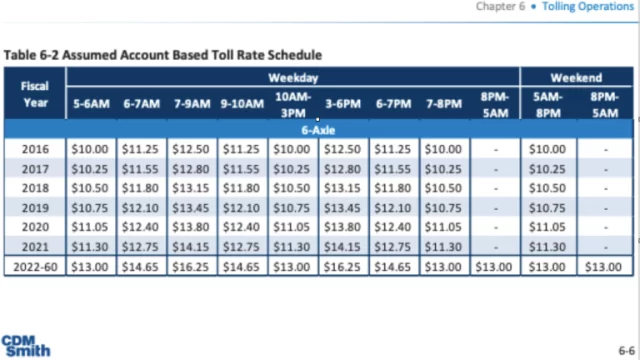
Where toll rate data comes from
As we’ve said, ODOT has been very secretive about toll levels. We obtained the toll level estimates from a variety of ODOT documents. They include the following:
I-5 Bridge Replacement Tolls: Memorandum from Jennifer Johns of IBR to Aaron Breakstone of Metro, April 22, 2022. (Obtained via public records request).
Regional Mobility Pricing Program Tolls: Oregon Department of Transportation,, (2018). Portland Metro Area Value Pricing Feasibility Analysis Final Round 1 Concept Evaluation and Recommendations Technical Memorandum #3, 2018.
Surcharges for those without transponders and Truck Rate Multiplier: 2013 CDM Smith Investment Grade Analysis of Columbia River Crossing.
I-205 Abernethy and Tualatin River Bridge Tolls: KGW TV reports.
- “Tolls expected on I-205 South of Portland in Two years.” November 16, 2022.
- “Here’s how much tolls along I-205 may cost drivers” February 20, 2022
WSP for Oregon Department of Transportation, I-205 Toll Project, Level 2 Toll Traffic and Revenue Study Report, Revised October 2022 (obtained via public records request).
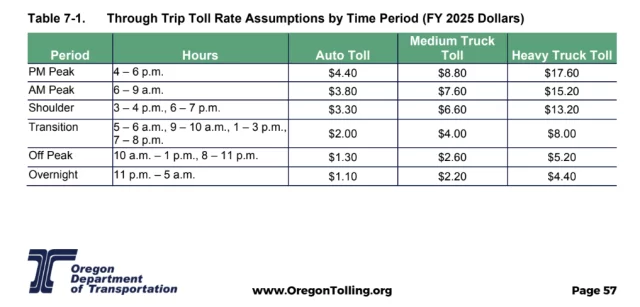
We have made multiple public records requests to ODOT for the latest information on planned tolls ODOT has declined to provide data on IBR and RMPP tolls. If ODOT would like to provide more accurate information, City Observatory will revise this commentary to reflect those data.
